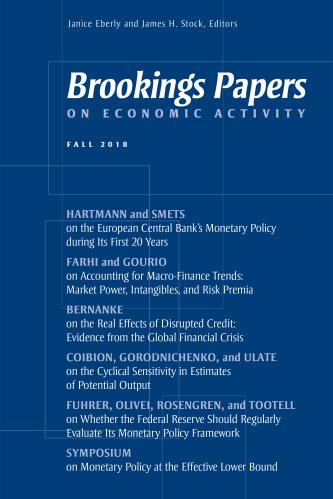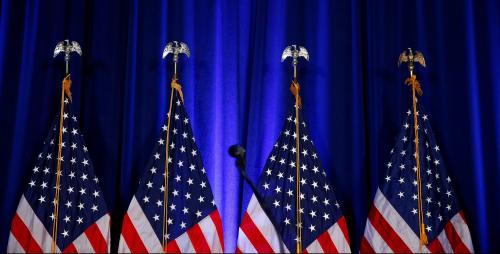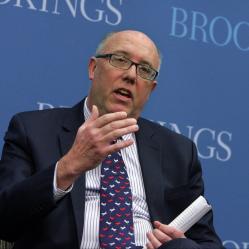Content from the Brookings Institution India Center is now archived. After seven years of an impactful partnership, as of September 11, 2020, Brookings India is now the Centre for Social and Economic Progress, an independent public policy institution based in India.
Content from the Brookings-Tsinghua Public Policy Center is now archived. Since October 1, 2020, Brookings has maintained a limited partnership with Tsinghua University School of Public Policy and Management that is intended to facilitate jointly organized dialogues, meetings, and/or events.
President Trump issued some major foreign policy promises during his campaign. After 100 days in the White House, what has his administration achieved, and what could be yet to come? Experts from across Brookings’s Foreign Policy program offer their analysis.
David Dollar, on trade and China: Trump in his first 100 days has not followed through on his harsh rhetoric about trade in general and trade with China in particular, much to the relief of the business community and America’s partners. He did not name China a currency manipulator and has not imposed high tariffs or other protectionist measures, as threatened during his campaign. This is a sensible adjustment, because a trade war would hurt the U.S. economy and make other economic targets harder to meet.
It seems that globalists have the upper hand over nationalists at this early stage of the administration. While not taking any trade measures against China, President Trump will continue the high-level economic dialogue with China pursued by Presidents Bush and Obama (now renamed the Comprehensive Economic Dialogue). The two sides have agreed to produce a 100-day action plan to address the large trade imbalance. China will no doubt be willing to make some small market opening moves, but is unlikely to do anything significant in this political year leading up to the 19th party congress. The United States, in turn, is probably not willing to move on China’s key asks—recognizing it as a market economy and lifting export controls on high-tech products. So, there is not much basis for a grand bargain here.
The other thing that Trump has done in the trade arena is initiate a series of studies: about the source of the U.S. trade deficit in terms of products and countries, and about the potential for steel imports to undermine security. To some extent, these studies are a delaying tactic. But as the results come in, they will raise again the specter of rising U.S. protectionism. The dangerous scenario would be if there is little progress in the economic dialogue with China, a rising trade imbalance between the two, and detailed ideas about import restrictions emerging from the studies. The imbalance will be affected by macroeconomic developments: if there is fiscal stimulus and monetary tightening on the U.S. side, it is very likely that the U.S. trade deficit with the world and with China will expand, irrespective of any marketing opening moves by China. The truce in U.S.-China trade may prove to be only temporary.
It seems that globalists have the upper hand over nationalists at this early stage of the administration.
Vanda Felbab-Brown, on Mexico and NAFTA: Hallmark elements of Trump’s presidential campaign were his promises to build a wall along the U.S.-Mexico border and renegotiate or scrap the North America Free Trade Agreement (NAFTA). A hundred days into his presidency, major uncertainties and much policy chaos surround both pledges.
Regarding the wall, the uncertainty isn’t completely bad. Costly and ineffective, the wall will not make the United States safer or stop illegal drugs, undocumented workers, or asylum seekers. Drug traffickers will learn to go under, over, and around the wall. Asylum seekers merely need to cross into the U.S. territory where the wall (and existing fence) is set off away from the actual border. People can always be smuggled by boat. Rather, U.S. southern border security requires good cooperation with Mexico. A wall of concrete is a waste of taxpayers’ money, and the United States can’t easily make Mexico pay for it.
The chaos, flip-flopping, and bluster surrounding Trump’s post-elections declarations regarding NAFTA, however, are a serious problem. NAFTA provides crucial economic benefits not just for Mexico and Canada, but also for U.S. businesses and even Trump’s electoral base. A collapse of NAFTA will increase the cost of many U.S. consumer goods, from avocados to electronics and cars, making struggling lower-class white families particularly hurt. Supply chains will be undermined, and U.S. global competitiveness will worsen. There are many important opportunities to improve and modernize NAFTA. The Trump administration can yet—and should—embrace them. Dropping the counterproductive brinkmanship of bluster toward Mexico and Canada is a first step.
Steven Pifer, on nuclear arms control: At President Trump’s 100-day mark, his administration has sent mixed signals about the importance it attaches to nuclear arms control. In a February phone call with Vladimir Putin, the president reportedly did not know what the New Strategic Arms Reduction Treaty (New START) was, then turned aside Putin’s suggestion to consider extending it and instead called it a bad Obama deal. One month later, however, the commander of U.S. Strategic Command and the vice chairman of the Joint Chiefs of Staff made clear the importance that the U.S. military attaches to New START.
The administration has launched a nuclear posture review, which among other things will inform its approach to arms control. The process hopefully will afford an opportunity for U.S. military leaders to explain to the president why they support New START’s limits as well as its verification and transparency measures, which yield information about Russian strategic nuclear forces that otherwise could cost billions of dollars to collect.
One early issue facing the administration is what to do about the 1987 Intermediate-range Nuclear Forces (INF) Treaty, which bans all U.S. and Russian ground-launched missiles with ranges between 500 and 5,500 kilometers. Russia has violated that treaty by testing and deploying a prohibited ground-launched cruise missile. Some propose that the U.S. government abandon the treaty. The administration should be cautious; it could be seen as responsible for killing the treaty, which would leave Russia free to deploy INF missiles without restraint, when the U.S. military presently has no planned counterpart and would need years to build one. It would be smarter for Washington to seek leverage to try to persuade the Kremlin to come back into compliance with the treaty.
Bruce Riedel, on the Gulf: In its first 100 days, the Trump administration has avidly courted Saudi Arabia, and Riyadh has responded with an enthusiastic embrace of the president. In February, the administration sent CIA Director Mike Pompeo to Riyadh on his first foreign trip to meet with Crown Prince Mohammed bin Nayef, the head of Saudi counterterrorism; Pompeo awarded the prince the George Tenet medal for his years of success in battling al-Qaida and the Islamic State. The White House then invited Deputy Crown Prince and Defense Minister Mohammed bin Salman to meet with the president and have lunch with him and his top lieutenants. Secretary of Defense Jim Mattis traveled to the kingdom in April for meetings with King Salman, promising to reinvigorate America’s oldest alliance in the Middle East.
The Saudis are eager to see the end of Barack Obama and Hillary Clinton, who also courted the kingdom but supported human rights, political reforms, and gender equality. Trump has made clear that he will not press those issues. Instead, he will concentrate on fighting Iranian influence and subversion. King Salman is the most strident royal critic of Iran in Saudi history. He has made conflict with Iran the signature issue of his reign, especially in the now two years-old war in Yemen.
The king has very high expectations of the Trump team. The royal palace expects full support for its war in Yemen,—regardless of the dire humanitarian consequences—a strategy to oust Bashar Assad in Syria after the president’s cruise missile strike, and a substantial reduction in Iranian influence in Iraq. Meanwhile, some in the palace may expect the Americans to orchestrate regime change in Tehran. It’s an ambitious agenda for the president to deliver. Courting the court comes with consequences.
Richard Bush, on the Asia-Pacific: The good news is that in its first 100 days, the administration reduced at least some of the uncertainty in East Asia about U.S. policy that Donald Trump himself created during the campaign. Even before January 20, his officials reaffirmed the centrality of alliances in our policy towards the region and informed Japan and South Korea that all the talk about allies paying their fair share for a U.S. security commitment didn’t apply to them. After generally demonizing China during the campaign, President Trump had a good meeting with Chinese President Xi Jinping at Mar-a-Lago, at least in terms of personal chemistry.
After suggesting that Washington’s historical One-China policy concerning relations with Taiwan might be used as leverage to extract concessions from China on other issues, Trump said that he would honor the policy—thus avoiding an unnecessary spat. After repeatedly saying that China could solve America’s North Korea problem, Trump now conveys understanding that Beijing’s relationship with North Korea is quite complicated. After ignoring Southeast Asia before November 8, he will reportedly attend the Asia-Pacific Economic Cooperation meeting and the East Asian summit at the end of the year.
The bad news has as much to do with process than it does with policy. Trump got off to a bad start with Australia by venting about immigration during what was supposed to be a courtesy call with Prime Minister Turnbull. Although message discipline is essential in dealing with North Korea in the annual spring tensions with Pyongyang, senior officials have said a wide range of things about how much danger North Korea actually represents now, and about what we will do about that threat. President Trump made the situation worse on April 27 by telling South Korea out of the blue that he expected it to pay for the THAAD missile defense system now being installed and that the United States would renegotiate its Free Trade Agreement with Korea. Communication with Asian countries doesn’t always occur through established channels, with China as the main case and point. The failure to even begin to fill key policy positions in the State and Defense Departments only compounds a low level of inter-agency coordination.
In short, the first 100 days could have been a lot worse, but a lot remains to be done in the second 100 days.
Kemal Kirisci, on Turkey: As the Trump administration completes its first 100 days, U.S. relations with Turkey, are facing ever-growing challenges. Less than two weeks ago, a tightly split vote gave the current president of Turkey, Recep Tayyip Erdoğan, enhanced executive powers with few checks and balances. Trump enthusiastically congratulated his Turkish counterpart, breaking from a long-established U.S. commitment to anchor Turkey among a community of liberal democracies.
In a recent report on U.S.-Turkish relations, we argued that the United States has the possibility to help put into place a deal between Turkey and Syrian Kurds—whom Ankara has bombed, but with whom Washington cooperates. The United States has played a helpful role for Turkey in the past, in reconciling Turkey with Kurds, and can draw on those models to do so again.
The planned meeting between Trump and Erdoğan in mid-May should provide an opportunity for the new administration to address the array of challenges in U.S.-Turkey relations. However, it will be very important that the Trump administration focus on helping to anchor Turkey into the international liberal order, a task for which it can draw on the rich institutional experience and know-how in the State Department and beyond.
Cooperation with Europe will be key, as well: Recent Dutch and French election results—together with opinion surveys on the September German elections—suggest that the European electorate might well be taking a pause from a populist cause once feared. There could be opportunities for the United States to work more closely with the EU on Turkey—it was this kind of cooperation, after all, that had helped Turkey become (at one time) an economic and governance model around the world. A stable and democratic Turkey would be much better equipped to work in harmony with the United States and help to meet the broader challenges in Turkey’s neighborhood.
Steven Pifer, on Russia and Ukraine: Donald Trump’s election victory in November prompted celebrations in Moscow and anxiety in Kyiv and Central Europe. After all, candidate Trump had called NATO obsolete and suggested he would radically change U.S. policy toward Russia, seeking a better relationship without first asking the Kremlin to correct its egregious misbehavior—such as its aggression against Ukraine—and suggesting he might recognize Crimea’s illegal annexation.
Three months into the Trump administration, Russians are disappointed while Ukrainians and Central Europeans breathe easier. Shaped by Vice President Pence, National Security Advisor McMaster, and Secretaries Mattis and Tillerson, U.S. policy toward Europe has largely followed a mainstream Republican approach: support for NATO, support for Ukraine, and a wary skepticism about Russia. The U.S. military has carried out Obama administration plans to bolster its conventional force presence in the Baltic region. All that has reassured Ukraine as well as U.S. allies in Europe. During his April 12 discussions in Moscow, Tillerson outlined the right approach: He proposed to open channels to discuss problems while making clear that Russia’s conflict with Ukraine posed a large impediment to an improved U.S.-Russia relationship.
That said, it does not appear that the president is instinctively supportive of NATO or inclined to criticize Russia. Allies, Russians, Ukrainians, pundits, and U.S. government officials will be looking for signs as to whether he is fully on board with the policy outlined by his senior advisers, or whether he might use a tweet to launch U.S. policy in a very different direction.
Of course, there remains the elephant in the room: the ongoing investigations into contacts between the Trump campaign and Russians. That complicates whatever policy the president might choose to pursue with the Kremlin.
Dhruva Jaishankar, on India: Donald Trump’s first 100 days has witnessed some actual attempts to follow through on his campaign rhetoric. There was the poorly-worded executive order on immigration (the so-called “Muslim ban”), his withdrawal from the Trans-Pacific Partnership, and an executive order on Buy American, Hire American. At the same time, confusion has reigned with the sudden replacement of his national security advisor, his walking back on matters such as NATO, and the continued absence of senior policymakers below his cabinet. These factors have contributed to several uncertainties concerning American openness (which is really what makes American great), his China policy, his counterterrorism priorities, and his approach to global governance.
While continuing to try to engage with the White House, countries like India have little choice but to deepen their outreach to the U.S. Congress, state governments, and the American private sector. At the same time, other partners—not least Europe and Japan, but also in some respects Russia and China—have grown in relevance from New Delhi’s point of view. In the long run, a partnership with the United States is still necessary and beneficial. But in the short run, India still needs a backup plan.













Commentary
An assessment of Trump’s first 100 days of foreign policy, from Brookings experts
April 28, 2017